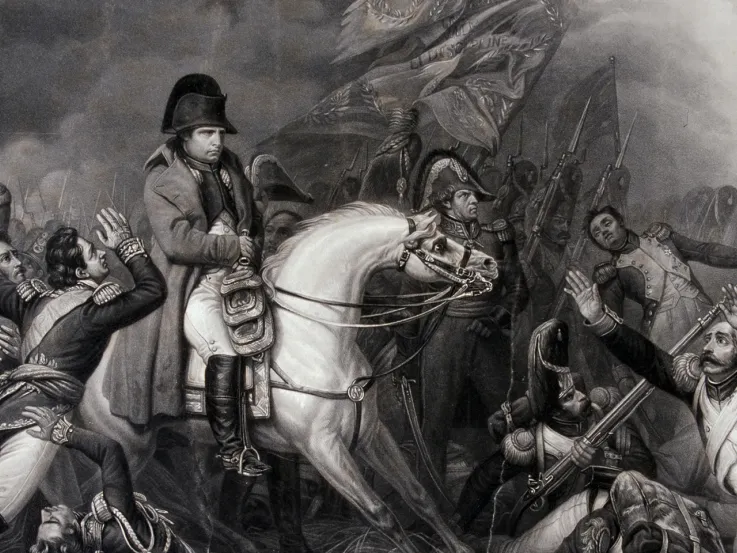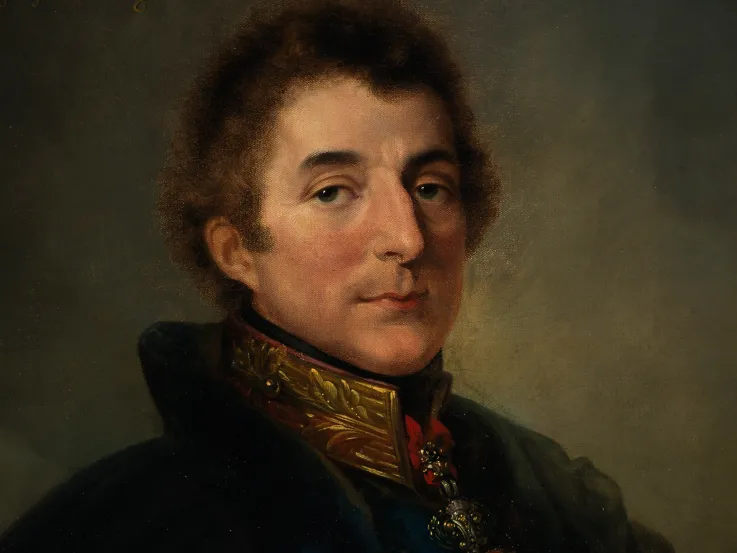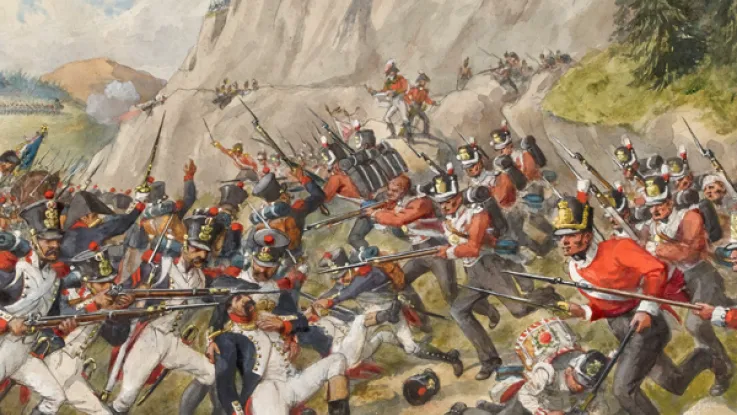Wounded in action
On 18 June 1815, Thomas Harris was severely wounded during the Battle of Waterloo. To save his life, his right arm had to be amputated.
Two hundred years later, in 2015, Harris's descendants donated to the National Army Museum the coatee he wore at the battle. But, before doing so, they arranged both historical and scientific analysis to confirm its authenticity.
Analysis
The physical state of the coatee largely corroborates the written evidence of how Harris was wounded and subsequently treated. It is severely stained with blood and the right sleeve has been fully slit open to allow access to the shattered arm.
Although written accounts say that Harris was struck simultaneously by grapeshot and a musket ball, forensic examination by researchers at Cranfield University suggests that the entry and exit holes could indicate a single musket ball passing through the arm and lodging in Harris's side.
The team at Cranfield also carried out radiocarbon dating and collected soil samples from the coatee. They were then able to match them to samples taken from the specific area of the Waterloo battlefield where Harris is known to have been wounded.

Engraving of Harris from his biography, c1815
Early career
Thomas Noel Harris was a career soldier. He claimed to have fought in 30 major battles and many more skirmishes. Born in 1785, he joined the British Army as an ensign in the 87th Regiment of Foot in 1801. He became a lieutenant in the 52nd Regiment of Foot in 1802, before purchasing a captaincy in the 18th Light Dragoons in 1807.
Having been refused a transfer to half-pay, he sold his commission and retired partly due to ill health. This was possibly also due to family pressure following the death of his brother, an officer of the East India Company.
However, he rejoined the Army in 1811, starting back at the bottom of the officer ranks as a cornet in the 13th Light Dragoons. He was subsequently promoted to a lieutenancy in his former regiment, the 18th Light Dragoons, with whom he served in the Peninsular War (1808-14) from 1811 to 1813.
German campaign
From Spain, he was sent to Germany, where he served as aide-de-camp to Sir Charles Stewart (later Sir Charles Vane, 3rd Marquess of Londonderry).
He was present at the battles of Grossbergen (or Grossbeeren) on 23 August 1813 and Dennewitz on 6 September 1813, and particularly distinguished himself at Leipzig on 16-19 October 1813. In his narrative of the campaign, Vane described Harris as 'most active and intrepid' throughout.
Harris was attached to the staff of the Prussian General Blücher from late 1813 to early 1814. He reportedly received a gold ring and the feathers from Blücher’s hat as a token of his esteem. After Waterloo, he met Blücher again in Paris, where he was warmly embraced and addressed as ‘mein lieber Harris’.
Celebrity
Harris became a national hero in April 1814 when he arrived in London carrying news of the capitulation of Paris and Napoleon’s abdication. He was reported to have ridden 400 miles (644km) without rest, fighting off attempts by bands of allied soldiers to rob and murder him.
In October 1814, Harris received the Royal Prussian Order of Military Merit and the Imperial Russian Order of St Vladimir, 4th Class. Later, he also received the Russian Imperial Order of St Anna.
‘Captain Harris, who was the bearer of the late glorious dispatches from Paris, experienced considerable difficulties in making his way to the sea coast. He was repeatedly attacked by the Cossacks on his route, although under the protection of a Russian officer and a body of Cossacks… on one occasion Captain Harris was nearly cut down, in spite of the efforts of his friends… his hat was cut to pieces, and this circumstance accounts for his appearing in London with a common Dragoon’s foraging cap… but for the resistance provided by his military collar one of the blows received by Captain Harris could have been fatal.’The Star — April 1814
Waterloo campaign
In April 1815, Harris was appointed brigade-major to the 18th Hussars under Sir Richard Hussey Vivian. He was at the Duchess of Richmond’s ball on 15 June, when news of Napoleon's advance broke, and immediately set off to rejoin his regiment. He fought at both Quatre Bras and Waterloo, wearing this coatee.
At Waterloo, Harris had two horses shot from under him. Very late in the battle, while leading a squadron of the 18th Hussars in a charge, he was shot in the chest and arm. He lay wounded on the field overnight, and was only found the next morning by his cousin, Lieutenant Wallington of the 10th Hussars, who was searching the battlefield for his body.
‘He was too far gone from loss to blood to speak, but with difficulty summoned sufficient strength to emit a low whistle, a circumstance which saved him from being left for dead on the battlefield.’Clement B Harris, 'Brief Memoir of the late Lieutenant-Colonel Sir Thomas Noel Harris, KH' — 1893
Surgery
The surgeon at Hougoumont cut open the sleeve of Harris's coat and, without anaesthetic, amputated his right arm above the elbow. Despite this trauma, Harris is said to have remarked to the surgeon in a faint voice that he would like to shake hands with his arm once more before parting.
The musket ball was never removed - it was deemed too dangerous to do so - and the injury gave Harris trouble for the rest of his life. However, despite missing a limb, he continued to hunt, shoot and fish. Extraordinarily, he once managed to swim two miles to shore after his boat had capsized.
Later life
Harris became a lieutenant-colonel in 1823. After being appointed Inspecting Field-Officer of Militia in Nova Scotia and then Surveyor-General at Halifax, Nova Scotia, he retired on half-pay in 1830. He returned home in 1832 and then became assistant Adjutant-General in Dublin.
He retired fully from the Army in September 1834, before becoming Chief Magistrate in Gibraltar. However, the heat there affected his wife, so he resigned and again returned to England.
In 1840, he was made a Groom of the Privy chamber to Queen Victoria. He was knighted in 1841 for military services. He served as Deputy Lieutenant of Kent and died in 1860.
See it on display
Come and see this coatee in our Formation gallery. You'll find it displayed alongside other items that introduce the Army's role in maintaining the balance of power in Europe.















